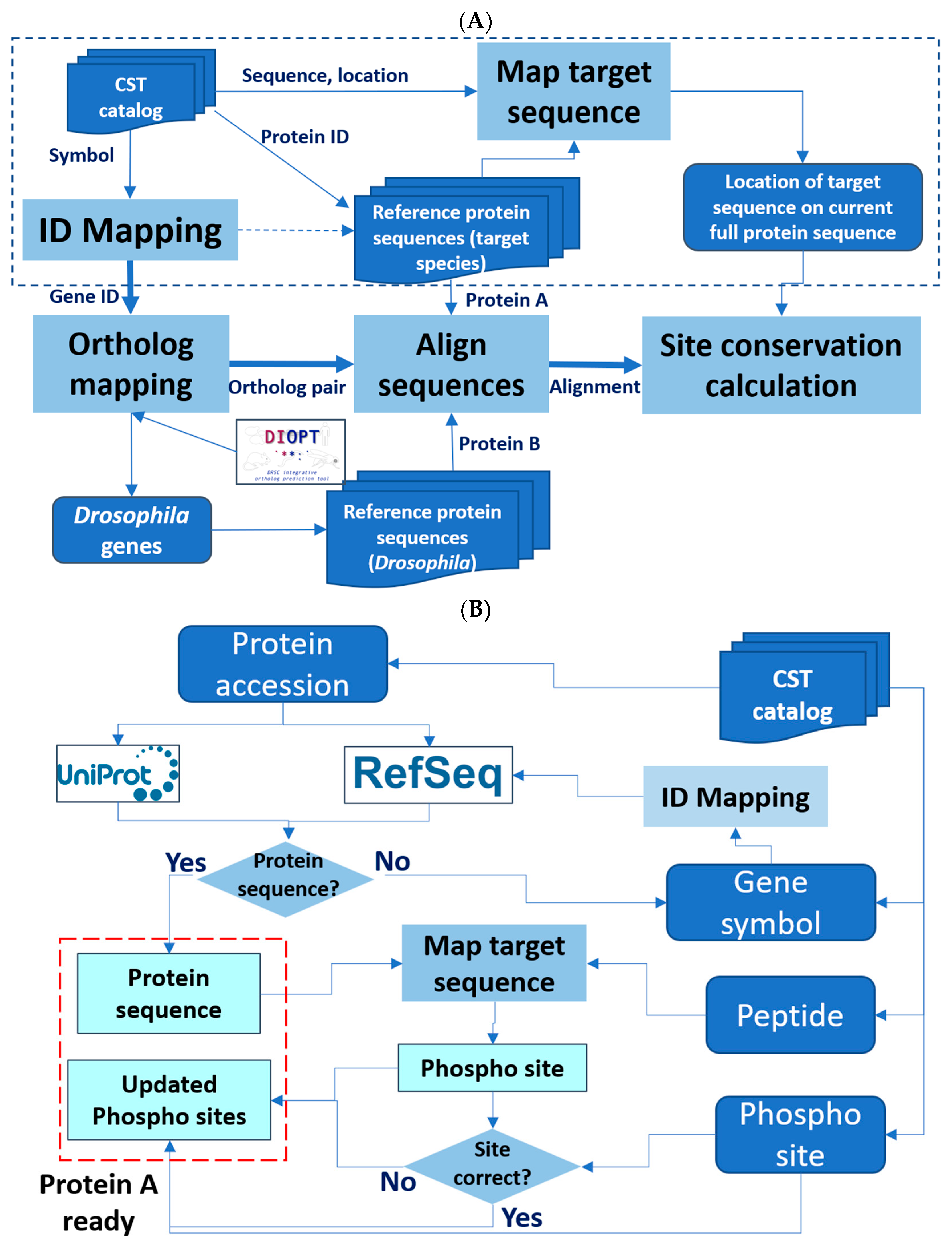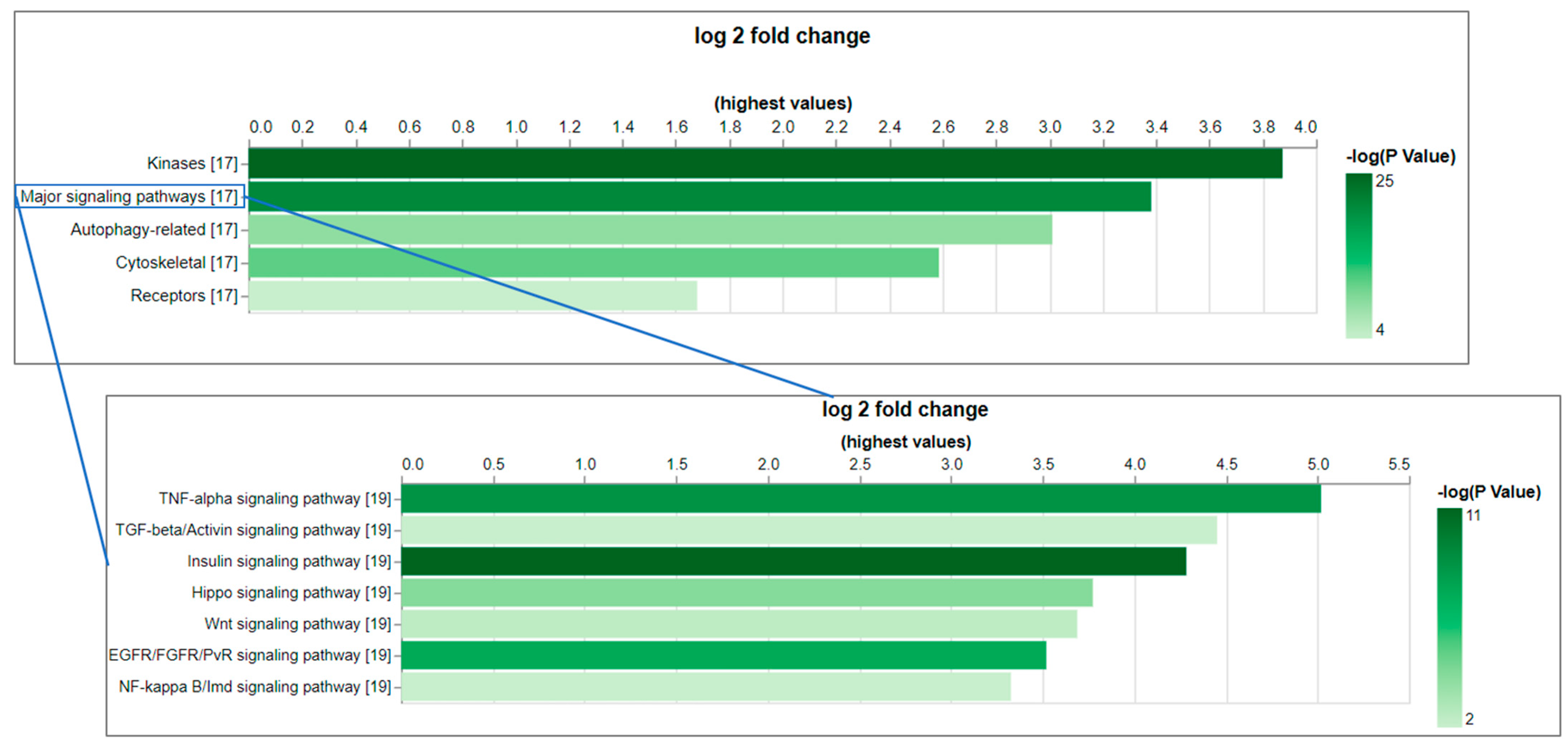Cross-Species Epitope Sequence Analysis for Discovery of Existing Antibodies Useful for Phospho-Specific Protein Detection in Model Species
Abstract
1. Introduction
2. Results
2.1. Defining Rules for Predicting Cross-Reactivity of Phospho-Specific Antibodies with Orthologous Proteins in Non-Target Species
2.2. Development of the Cross-Species Epitope Sequence Analysis (CESA) Software Tool
2.3. Application of CESA to Predict Drosophila Targets of Phosphosite Antibodies
3. Methods
3.1. Tool Development
3.2. Information Retrieval
3.3. Antibody Testing
3.4. Code Availability
4. Discussion
Supplementary Materials
Author Contributions
Funding
Data Availability Statement
Acknowledgments
Conflicts of Interest
References
- Milburn, M.V.; Tong, L.; Devos, A.M.; Brünger, A.; Yamaizumi, Z.; Nishimura, S.; Kim, S.-H. Molecular switch for signal transduction: Structural differences between active and inactive forms of protooncogenic ras proteins. Science 1990, 247, 939–945. [Google Scholar] [CrossRef] [PubMed]
- Ghusinga, K.R.; Jones, R.D.; Jones, A.M.; Elston, T.C. Molecular switch architecture determines response properties of signaling pathways. Proc. Natl. Acad. Sci. USA 2021, 118, e2013401118. [Google Scholar] [CrossRef] [PubMed]
- Bjorling, E.; Uhlen, M. Antibodypedia, a portal for sharing antibody and antigen validation data. Mol. Cell. Proteom. 2008, 7, 2028–2037. [Google Scholar] [CrossRef] [PubMed]
- Hornbeck, P.V.; Chabra, I.; Kornhauser, J.M.; Skrzypek, E.; Zhang, B. PhosphoSite: A bioinformatics resource dedicated to physiological protein phosphorylation. Proteomics 2004, 4, 1551–1561. [Google Scholar] [CrossRef]
- Hornbeck, P.V.; Kornhauser, J.M.; Latham, V.; Murray, B.; Nandhikonda, V.; Nord, A.; Skrzypek, E.; Wheeler, T.; Zhang, B.; Gnad, F. 15 years of PhosphoSitePlus(R): Integrating post-translationally modified sites, disease variants and isoforms. Nucleic Acids Res. 2019, 47, D433–D441. [Google Scholar] [CrossRef] [PubMed]
- Xia, B.; Viswanatha, R.; Hu, Y.; Mohr, S.E.; Perrimon, N. Pooled genome-wide CRISPR activation screening for rapamycin resistance genes in Drosophila cells. Elife 2023, 12, e85542. [Google Scholar] [CrossRef]
- Hu, Y.; Flockhart, I.; Vinayagam, A.; Bergwitz, C.; Berger, B.; Perrimon, N.; Mohr, E.S. An integrative approach to ortholog prediction for disease-focused and other functional studies. BMC Bioinform. 2011, 12, 357. [Google Scholar] [CrossRef]
- Hu, Y.; Comjean, A.; Attrill, H.; Antonazzo, G.; Thurmond, J.; Chen, W.; Li, F.; Chao, T.; Mohr, E.S.; Brown, N.H.; et al. PANGEA: A new gene set enrichment tool for Drosophila and common research organisms. Nucleic Acids Res. 2023, 51, W419–W426. [Google Scholar] [CrossRef] [PubMed]
- Hu, Y.; Sopko, R.; Chung, V.; Foos, M.; Studer, A.R.; Landry, S.D.; Liu, D.; Rabinow, L.; Gnad, F.; Beltrao, P.; et al. iProteinDB: An Integrative Database of Drosophila Post-translational Modifications. G3 2019, 9, 1–11. [Google Scholar] [CrossRef] [PubMed]


| Human Gene | Fly Gene | Human Site +/−7 AA | Fly Site +/−7 AA | Conserved Region (Continues AA) |
|---|---|---|---|---|
| AKT1 | Akt1 | RPHFPQFSYSASGTA | EPLFPQFSYQGDMAS | 6 |
| PRKAA1 | AMPKalpha | SDGEFLRTSCGSPNY | LDGEFLRTSCGSPNY | 14 |
| MAPK10 | bsk | AGTSFMMTPYVVTRY | AGTTFMMTPYVVTRY | 11 |
| MAPK10 | bsk | TSFMMTPYVVTRYYR | TTFMMTPYVVTRYYR | 13 |
| EIF2S1 | eIF2alpha | MILLSELSRRRIRSI | MILLSELSRRRIRSI | 15 |
| MAPK12 | p38a | RQADSEMTGYVVTRW | RPTENEMTGYVATRW | 6 |
| MAPK12 | p38a | ADSEMTGYVVTRWYR | TENEMTGYVATRWYR | 6 |
| MAPK1 | rl | HDHTGFLTEYVATRW | HDHTGFLTEYVATRW | 15 |
| MAPK1 | rl | HTGFLTEYVATRWYR | HTGFLTEYVATRWYR | 15 |
| RPS6KB1 | S6k | NQVFLGFTYVAPSVL | NLIFQGFTYVAPSIL | 8 |
| EIF4EBP1 | Thor | PPGDYSTTPGGTLFS | MPEVYSSTPGGTLYS | 6 |
| EIF4EBP1 | Thor | GGTLFSTTPGGTRII | GGTLYSTTPGGTKLI | 7 |
| Species | Sites | Genes | Sites with Antibody | Genes with Antibody | Sites Conserved in Fly | Sites Conserved in Frog | Sites Conserved in Fish | Sites Conserved in Mosquito | Sites Conserved in Worm |
|---|---|---|---|---|---|---|---|---|---|
| human | 240,118 | 17,467 | 1019 | 485 | 187 | 658 | 599 | 181 | 114 |
| mouse | 105,223 | 13,475 | 774 | 407 | 171 | 514 | 485 | 160 | 107 |
| rat | 31,721 | 7261 | 508 | 278 | 116 | 328 | 311 | 111 | 72 |
| other | 1893 | 676 | 56 | 33 | NA | NA | NA | NA | NA |
| Cut-Off of Conserved Region (aa) | Fly D. melanogaster | Frog X. tropicalis | Zebrafish D. rerio | Mosquito A. gambiae | Worm C. elegans |
|---|---|---|---|---|---|
| 6 | 115 | 472 | 599 | 97 | 76 |
| 7 | 111 | 458 | 578 | 91 | 73 |
| 8 | 105 | 446 | 564 | 87 | 70 |
| 9 | 97 | 431 | 544 | 83 | 68 |
| 10 | 92 | 418 | 518 | 77 | 67 |
| 11 | 88 | 399 | 495 | 73 | 67 |
Disclaimer/Publisher’s Note: The statements, opinions and data contained in all publications are solely those of the individual author(s) and contributor(s) and not of MDPI and/or the editor(s). MDPI and/or the editor(s) disclaim responsibility for any injury to people or property resulting from any ideas, methods, instructions or products referred to in the content. |
© 2025 by the authors. Licensee MDPI, Basel, Switzerland. This article is an open access article distributed under the terms and conditions of the Creative Commons Attribution (CC BY) license (https://creativecommons.org/licenses/by/4.0/).
Share and Cite
Hu, Y.; Gao, C.; McKenna, W.; Xia, B.; Ariss, M.; Mohr, S.E.; Perrimon, N. Cross-Species Epitope Sequence Analysis for Discovery of Existing Antibodies Useful for Phospho-Specific Protein Detection in Model Species. Int. J. Mol. Sci. 2025, 26, 558. https://doi.org/10.3390/ijms26020558
Hu Y, Gao C, McKenna W, Xia B, Ariss M, Mohr SE, Perrimon N. Cross-Species Epitope Sequence Analysis for Discovery of Existing Antibodies Useful for Phospho-Specific Protein Detection in Model Species. International Journal of Molecular Sciences. 2025; 26(2):558. https://doi.org/10.3390/ijms26020558
Chicago/Turabian StyleHu, Yanhui, Chenxi Gao, William McKenna, Baolong Xia, Majd Ariss, Stephanie E. Mohr, and Norbert Perrimon. 2025. "Cross-Species Epitope Sequence Analysis for Discovery of Existing Antibodies Useful for Phospho-Specific Protein Detection in Model Species" International Journal of Molecular Sciences 26, no. 2: 558. https://doi.org/10.3390/ijms26020558
APA StyleHu, Y., Gao, C., McKenna, W., Xia, B., Ariss, M., Mohr, S. E., & Perrimon, N. (2025). Cross-Species Epitope Sequence Analysis for Discovery of Existing Antibodies Useful for Phospho-Specific Protein Detection in Model Species. International Journal of Molecular Sciences, 26(2), 558. https://doi.org/10.3390/ijms26020558






